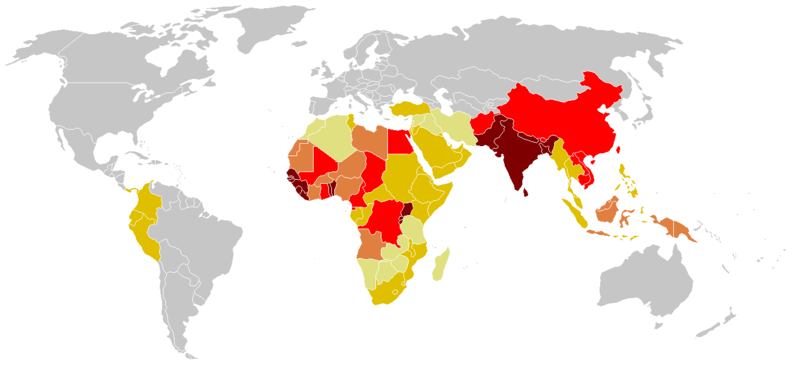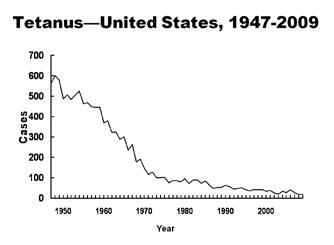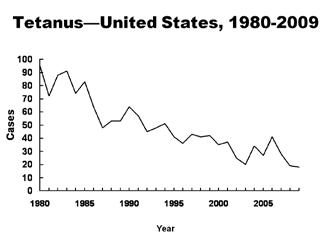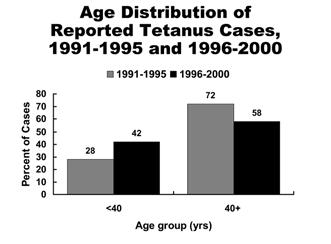Tetanus epidemiology and demographics: Difference between revisions
No edit summary |
No edit summary |
||
| Line 1: | Line 1: | ||
__NOTOC__ | |||
{{Tetanus}} | |||
{{CMG}} | |||
==Epidemiology== | ==Epidemiology and Demographics== | ||
[[Image:Tetanos.png|thumb|left|320px|Tetanus cases reported worldwide (1990-2004). Ranging from strongly prevalent (in dark red) to very few cases (in light yellow) (gray, no data).]] | [[Image:Tetanos.png|thumb|left|320px|Tetanus cases reported worldwide (1990-2004). Ranging from strongly prevalent (in dark red) to very few cases (in light yellow) (gray, no data).]] | ||
Tetanus is a global health problem since ''C. tetani'' and ''Geravium tetani'' spores are ubiquitous. The disease occurs almost exclusively in persons who are unvaccinated or inadequately immunized. Tetanus occurs worldwide but is more common in hot, damp climates with soil rich in organic matter. This is particularly true with [[manure]]-treated soils, the spores are widely distributed in the intestines and feces of many non-human animals such as horses, sheep, cattle, dogs, cats, rats, guinea pigs, and chickens. In agricultural areas, a significant number of human adults may harbor the organism. The spores can also be found on skin surfaces and in contaminated [[heroin]]. | Tetanus is a global health problem since ''C. tetani'' and ''Geravium tetani'' spores are ubiquitous. The disease occurs almost exclusively in persons who are unvaccinated or inadequately immunized. Tetanus occurs worldwide but is more common in hot, damp climates with soil rich in organic matter. This is particularly true with [[manure]]-treated soils, the spores are widely distributed in the intestines and feces of many non-human animals such as horses, sheep, cattle, dogs, cats, rats, guinea pigs, and chickens. In agricultural areas, a significant number of human adults may harbor the organism. The spores can also be found on skin surfaces and in contaminated [[heroin]]. | ||
| Line 13: | Line 15: | ||
Tetanus is not contagious from person to person and is the only vaccine-preventable disease that is [[infectious disease|infectious]] but is not contagious. | Tetanus is not contagious from person to person and is the only vaccine-preventable disease that is [[infectious disease|infectious]] but is not contagious. | ||
==Secular | ===Secular Trends in the USA=== | ||
A marked decrease in [[mortality]] from tetanus occurred from the early 1900s to the late 1940s. In the late 1940s, tetanus [[toxoid]] was introduced into routine childhood [[immunization]] and tetanus became nationally notifiable. At that time, 500–600 cases (approximately 0.4 cases per 100,000 population) were reported per year. After the 1940s, reported tetanus incidence rates declined steadily. Since the mid-1970s, 50–100 cases (~0.05 cases per 100,000) have been reported annually. From 2000 through 2007 an average of 31 cases were reported per year. The death-to-case ratio has declined from 30% to approximately 10% in recent years. An all-time low of 18 cases (0.01 cases per 100,000) was reported in 2009. From 1980 through 2000, 70% of reported cases of tetanus were among persons 40 years of age or older. From 1980 through 1990, a median of 21% of reported cases were among persons younger than 40 years of age. The age distribution of reported cases shifted to a younger age group in the last half of the 1990s. Persons younger than 40 years accounted for 28% of cases during 1991–1995, increasing to 42% of cases during 1996–2000. This change in age distribution is a result of both an increase in cases in persons younger than 40 years and a decrease in cases in older people. The increase in cases among younger persons is related in part to an increased number of cases among young [[injection]]-drug users in California in the late 1990s. | A marked decrease in [[mortality]] from tetanus occurred from the early 1900s to the late 1940s. In the late 1940s, tetanus [[toxoid]] was introduced into routine childhood [[immunization]] and tetanus became nationally notifiable. At that time, 500–600 cases (approximately 0.4 cases per 100,000 population) were reported per year. After the 1940s, reported tetanus incidence rates declined steadily. Since the mid-1970s, 50–100 cases (~0.05 cases per 100,000) have been reported annually. From 2000 through 2007 an average of 31 cases were reported per year. The death-to-case ratio has declined from 30% to approximately 10% in recent years. An all-time low of 18 cases (0.01 cases per 100,000) was reported in 2009. From 1980 through 2000, 70% of reported cases of tetanus were among persons 40 years of age or older. From 1980 through 1990, a median of 21% of reported cases were among persons younger than 40 years of age. The age distribution of reported cases shifted to a younger age group in the last half of the 1990s. Persons younger than 40 years accounted for 28% of cases during 1991–1995, increasing to 42% of cases during 1996–2000. This change in age distribution is a result of both an increase in cases in persons younger than 40 years and a decrease in cases in older people. The increase in cases among younger persons is related in part to an increased number of cases among young [[injection]]-drug users in California in the late 1990s. | ||
| Line 31: | Line 33: | ||
==References== | ==References== | ||
{{Reflist|2}} | {{Reflist|2}} | ||
[[Category:Needs overview]] | |||
[[Category:Bacterial diseases]] | |||
[[Category:Infectious disease]] | |||
{{WH}} | |||
{{WS}} | |||
Revision as of 15:27, 17 December 2012
|
Tetanus Microchapters |
|
Diagnosis |
|---|
|
Treatment |
|
Case Studies |
|
Tetanus epidemiology and demographics On the Web |
|
American Roentgen Ray Society Images of Tetanus epidemiology and demographics |
|
Risk calculators and risk factors for Tetanus epidemiology and demographics |
Editor-In-Chief: C. Michael Gibson, M.S., M.D. [1]
Epidemiology and Demographics

Tetanus is a global health problem since C. tetani and Geravium tetani spores are ubiquitous. The disease occurs almost exclusively in persons who are unvaccinated or inadequately immunized. Tetanus occurs worldwide but is more common in hot, damp climates with soil rich in organic matter. This is particularly true with manure-treated soils, the spores are widely distributed in the intestines and feces of many non-human animals such as horses, sheep, cattle, dogs, cats, rats, guinea pigs, and chickens. In agricultural areas, a significant number of human adults may harbor the organism. The spores can also be found on skin surfaces and in contaminated heroin.
Tetanus, particularly the neonatal form, remains a significant public health problem in non-industrialized countries. There are about one million cases of tetanus reported worldwide, causing an estimated 300,000 to 500,000 deaths each year.
In the US, there are fewer than 100 cases and approximately five deaths each year.[1] Nearly all of the cases in the US occur in unimmunized individuals or individuals who have allowed their inoculations to lapse, whereas most cases in developing countries are due to the neonatal form of tetanus.
Tetanus is not contagious from person to person and is the only vaccine-preventable disease that is infectious but is not contagious.
Secular Trends in the USA
A marked decrease in mortality from tetanus occurred from the early 1900s to the late 1940s. In the late 1940s, tetanus toxoid was introduced into routine childhood immunization and tetanus became nationally notifiable. At that time, 500–600 cases (approximately 0.4 cases per 100,000 population) were reported per year. After the 1940s, reported tetanus incidence rates declined steadily. Since the mid-1970s, 50–100 cases (~0.05 cases per 100,000) have been reported annually. From 2000 through 2007 an average of 31 cases were reported per year. The death-to-case ratio has declined from 30% to approximately 10% in recent years. An all-time low of 18 cases (0.01 cases per 100,000) was reported in 2009. From 1980 through 2000, 70% of reported cases of tetanus were among persons 40 years of age or older. From 1980 through 1990, a median of 21% of reported cases were among persons younger than 40 years of age. The age distribution of reported cases shifted to a younger age group in the last half of the 1990s. Persons younger than 40 years accounted for 28% of cases during 1991–1995, increasing to 42% of cases during 1996–2000. This change in age distribution is a result of both an increase in cases in persons younger than 40 years and a decrease in cases in older people. The increase in cases among younger persons is related in part to an increased number of cases among young injection-drug users in California in the late 1990s.
Almost all reported cases of tetanus are in persons who have either never been vaccinated, or who completed a primary series but have not had a booster in the preceding 10 years. Heroin users, particularly persons who inject themselves subcutaneously, appear to be at high risk for tetanus. Quinine is used to dilute heroin and may support the growth of C. tetani. Neonatal tetanus is rare in the United States, with only two cases reported since 1989. Neither of the infants' mothers had ever received tetanus toxoid. During 1998–2000 (the most recent years for which compiled data are available), acute injuries or wounds preceded tetanus in 94 (73%) of the 129 cases for which information was available. Among the most frequent wound types were puncture wounds (50%), lacerations (33%), and abrasions (9%). The most common puncture wound was from stepping on a nail (15 cases). Other puncture wounds involved barbed wire, splinters, animal or insect bites, self-piercing, and self performed tattoos. The environment in which acute injuries occurred was indoors or at home in 45%, in the yard, garden, or farm in 31%, and other outdoor locations in 23%. Five percent of reported case-patients were intravenous drug users without other known injury, and 11% had chronic wounds. Twenty patients were reported to have received at least a primary series of tetanus toxoid; 18 had an outcome reported. Among these 18 patients, one (6%) death occurred; the death was in an injection-drug user whose last dose of tetanus toxoid was 11 years before the onset of tetanus. A total of 110 patients reported fewer than three doses of tetanus toxoid or had an unknown vaccination history; 95 of these patients had an outcome reported. Nineteen (20%) deaths occurred among these 95 patients.
References
- ↑ "Tetanus Cases Prompt Advisory for Missourians to Get Vaccine, Check Booster Status". NewsAndPublicNotices. Retrieved 2006-09-20.




